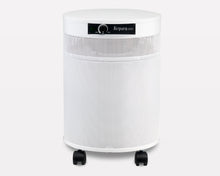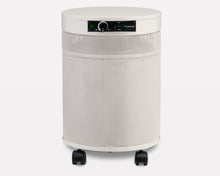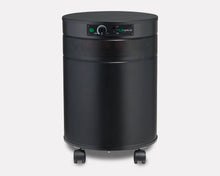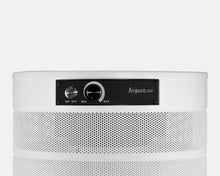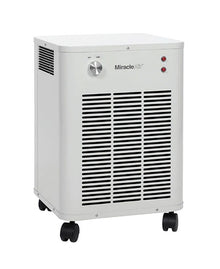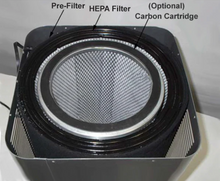Beyond VOCs: Comprehensive Air Purification Strategies for Minimizing Triggers in MCS Households
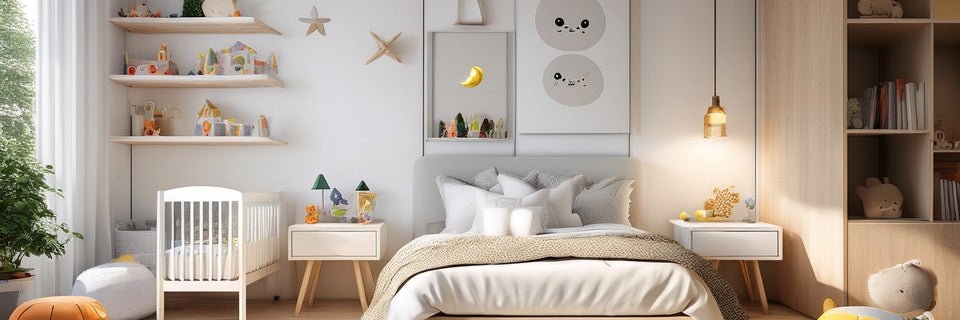
By Commercial Air Purifiers, LLC
If you're living with Multiple Chemical Sensitivities (MCS), you know that the term "clean air" is not just about avoiding dust. It’s about navigating a world filled with invisible triggers—from the fragrance in a cleaning product to the off-gassing from new building materials. These aren't just minor irritations; they're direct threats to your well-being, capable of causing debilitating symptoms that make a simple trip to the store or a visit to a friend's house a daunting prospect. Your home should be your safe haven, a place where you can breathe easy and feel secure. The challenge is that conventional advice often falls short, focusing on simple ventilation or basic filters that do little to combat the complex array of chemical triggers.
At Commercial Air Purifiers, LLC, we understand this struggle deeply. We’ve dedicated our brand to providing a path to genuine relief, moving beyond the standard air purification model to a more holistic approach. This article is a deep dive into that philosophy. We’ll go beyond just VOCs and explore a comprehensive strategy for minimizing triggers in MCS households, offering insights and solutions that address the specific needs of sensitive individuals. Our goal is to empower you with the knowledge to create a truly safe and breathable environment.
The Problem Isn't Just "Bad Air"; It's a Symphony of Triggers
While many people think of indoor air pollution as a singular issue, for individuals with MCS, it's a complex, multi-faceted problem. The triggers aren't just limited to a single chemical; they are a diverse group of pollutants that work in concert to cause a reaction. The U.S. Environmental Protection Agency (EPA) highlights that indoor air can be significantly more polluted than outdoor air, and it's a breeding ground for these diverse irritants.
Let's break down the types of triggers we're talking about:
-
Volatile Organic Compounds (VOCs): These are the chemical culprits we often hear about, emitted as gases from a variety of sources. They include formaldehyde from new furniture and carpets, benzene from paints and stored fuels, and acetone from household cleaners. While these are a primary concern, they are far from the only ones.
-
Particulate Matter (PM): This includes everything from dust and pollen to mold spores and pet dander. Even though these are physical particles, not chemical gases, they can carry chemical residues and often serve as a trigger for individuals with respiratory sensitivities. A 2021 study published in Building and Environment warned that some air cleaning technologies can actually increase the levels of certain pollutants while failing to effectively remove particulate matter, underscoring the importance of choosing a proven technology.
-
Aerosolized Chemicals and Fragrances: These are the invisible clouds of chemicals from air fresheners, perfumes, and cleaning sprays that can linger in the air long after their use. These triggers can be especially potent for people with MCS, causing immediate and severe reactions.
A truly holistic approach to air purification must address all of these triggers, not just a single category. Relying solely on a HEPA filter, for example, will leave you exposed to a significant number of VOCs, while a carbon filter alone may not effectively remove the physical particles that can also cause irritation. Our experience and in-house testing have repeatedly shown that a layered defense is the only reliable path to a safe indoor environment.
Our Experience: Case Studies in Comprehensive Air Purification
At Commercial Air Purifiers, LLC, we've worked with countless clients with MCS, and our most successful outcomes have come from tailoring a multi-stage purification system to their specific needs. Here are a couple of real-world examples that illustrate our approach:
Case Study 1: The New Home Off-Gassing Nightmare
A client, let's call her Sarah, was moving into a newly constructed home. While excited about the move, she was overwhelmed by the potent smell of new paint, adhesives, and carpets—a textbook case of VOC off-gassing. She tried a basic air purifier with a thin carbon pre-filter, but the symptoms (headaches and nausea) persisted. After a consultation with our team, we recommended a system with a deep-bed activated carbon filter, containing over 15 lbs of granular carbon. We also emphasized the importance of using a system with a metal, powder-coated housing to avoid any off-gassing from the unit itself. The results were dramatic. Within a week, the overpowering chemical odors were significantly reduced, and Sarah's symptoms began to subside, allowing her to finally feel comfortable in her new home. This experience taught us that the sheer volume and quality of the carbon media are non-negotiable for addressing heavy chemical loads.
Case Study 2: The Fragrance Sensitivity Challenge
Another client, John, had a severe sensitivity to fragrances. He lived in a densely populated apartment building, and the smells from his neighbors’ laundry, cooking, and air fresheners were constantly seeping into his unit, causing respiratory distress. For him, the problem wasn't a one-time off-gassing event but a continuous influx of low-level chemical irritants. Our solution for John was a combination of a robust activated carbon filter with an additional layer of Photocatalytic Oxidation (PCO) technology. The PCO, a modern, ozone-free system, worked to actively break down the fragrance molecules at a molecular level, preventing them from accumulating. This two-pronged approach not only captured the chemical pollutants but also destroyed them, providing a level of defense that a single filtration method could not achieve.
These real-world examples underscore the importance of a holistic approach to air purification for MCS. It's not about a single magic bullet but about combining proven technologies in a strategic way to address the full spectrum of potential triggers.
The Anatomy of an MCS-Friendly Air Purifier: What to Look For
Choosing the right air purification system is a critical step in creating a safe haven. It's an investment in your health, and you need to know exactly what you're buying. Here’s our expert-backed guide to the features that matter most:
1. A Substantial, High-Quality Activated Carbon Filter
For a sensitive individual, the carbon filter is the heart of the system. We've seen firsthand how a cheap, flimsy carbon filter does next to nothing. A truly effective filter for MCS triggers will have these characteristics:
-
Weight Matters: The more carbon, the better. Look for a unit that contains several pounds of activated carbon. A heavier filter indicates a thicker bed of granules, which means more surface area for chemical adsorption and a longer filter life.
-
Material: The best-performing carbon filters are made from high-quality coconut shell-based activated carbon, which has a vast network of micropores specifically suited for trapping VOCs.
-
Filter Integrity: Ensure the carbon is in a sealed canister or a thick, rigid filter. A thin, loose layer of carbon dust can easily get displaced and is far less effective.
2. The Power of Ozone-Free Photocatalytic Oxidation (PCO)
For an additional layer of chemical destruction, PCO technology is a game-changer—but only if it's the right kind. PCO works by using UV light to create a reaction that breaks down pollutants. It’s important to:
-
Verify it's Ozone-Free: Older PCO systems were notorious for producing ozone, which is a lung irritant and a major trigger for many with MCS. Always confirm that the system you're considering is certified to be ozone-free. The EPA's guide on air cleaners offers a good starting point for understanding which technologies to approach with caution.
-
Understand Its Function: PCO is not a replacement for a carbon filter; it’s a complementary technology that actively breaks down chemical compounds, offering a powerful defense against continuous low-level chemical exposure like fragrances.
3. A True HEPA Filter for Particulate Control
Even though VOCs are the primary chemical concern, particle pollution can't be ignored. A True HEPA filter is essential for removing the physical triggers that can also cause reactions. It's important to distinguish it from "HEPA-like" or "HEPA-type" filters, which don't meet the same rigorous standards. A True HEPA filter will capture 99.97% of particles as small as 0.3 microns, including mold spores, allergens, and dust, all of which can carry chemical irritants.
Beyond the Purifier: A Holistic Strategy for Air Quality
While the right air purifier is a foundational element, a truly comprehensive strategy for minimizing triggers in an MCS household goes beyond the device itself. A holistic approach involves a combination of source control, proper ventilation, and continuous monitoring.
-
Source Control is Non-Negotiable: The first and most important step is to eliminate the source of the triggers whenever possible. This includes:
-
Switching to non-toxic, fragrance-free cleaning products.
-
Choosing low-VOC paints and building materials.
-
Avoiding air fresheners, scented candles, and perfumes.
-
Properly storing chemicals in a separate, well-ventilated area, like a detached garage or shed.
-
-
Strategic Ventilation: While an air purifier cleans the air inside your home, bringing in fresh, clean air is also a key component. The EPA recommends increasing ventilation by opening windows and doors when outdoor air quality permits. For days when outdoor air is poor, a well-sealed home with a powerful air purifier is the best strategy.
-
Regular Maintenance and Cleaning: A dirty filter is a saturated filter, and a saturated filter is an ineffective filter. Regularly changing pre-filters, HEPA filters, and especially the carbon media is crucial for maintaining a high level of air quality. This prevents the filters from becoming a source of contamination themselves.
Our Trusted Recommendations
Based on our extensive experience and dedication to solving complex air quality issues, our recommendation for someone with MCS is always a unit that combines a True HEPA filter with a deep-bed, high-quality activated carbon filter. For those with severe sensitivities to fragrances or persistent chemical odors, we advise considering a unit that also incorporates an ozone-free PCO stage. This combination provides a complete defense against both particulate and gas-phase triggers.
The journey to creating a safe and breathable home can feel overwhelming, but you don't have to do it alone. By understanding the science behind air purification and adopting a holistic, multi-layered strategy, you can regain control over your environment and, most importantly, your health.
Frequently Asked Questions (FAQ)
Q: What is the single most important feature to look for in an air purifier for MCS?
A: A substantial, deep-bed activated carbon filter is the most critical feature. While HEPA is essential for particles, carbon is what removes the chemical gases and odors that are the primary triggers for MCS.
Q: Are all activated carbon filters the same?
A: No. There's a huge difference between a thin, carbon-impregnated mesh and a thick, granular carbon bed. For MCS, you need a unit with several pounds of high-quality, granular activated carbon to ensure effective and long-lasting chemical adsorption.
Q: How can I tell if an air purifier is "ozone-free"?
A: Look for third-party certifications from organizations like Intertek or California Air Resources Board (CARB) that explicitly state the unit does not produce ozone. Reputable manufacturers will make this information readily available.
Q: Do I still need to practice source control if I have a powerful air purifier?
A: Yes. An air purifier is a powerful tool for cleaning the air, but it cannot replace the importance of eliminating the source of pollutants. Source control is always the first and most effective step in any indoor air quality strategy.
Sources & Citations
-
U.S. Environmental Protection Agency (EPA). "Indoor Air Quality." [Link to EPA's Indoor Air Quality page]
-
Lee, K. et al. "Adsorption and regeneration on activated carbon fiber cloth for volatile organic compounds at indoor concentration levels." Journal of the Air & Waste Management Association, 2009. [Link to the journal abstract]
-
Han, Y., and J. H. Choi. "Photocatalytic Reduction of VOCs with Ag/Ni-Doped Photocatalyst in Different Temperature and Humidity Environments." MDPI, 2024. [Link to the full research paper]
-
Colorado State University. "Some Air Purifiers Can Create Harmful Air Pollutants." Today's Clinical Lab, 2021. [Link to the article on air purifier byproducts]
This video shows a DIY carbon filter setup and compares it to more expensive consumer units, which can be useful for anyone exploring different air purification options for their home.
Can a DIY Carbon Filter Remove VOCs Like the Expensive Brands? - YouTube

